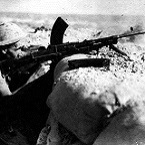thedoctorking
Posts: 2297
Joined: 4/29/2017
Status: offline

|
The Soviet response to this threat was to build a powerful defense in the land bridge sector, between Orsha and Vitebsk. The best Soviet generals are here, except for Rokossovsky, who is commanding an understrength mechanized corps in the swamps. Leadership is particularly important in this game. As the Soviets, you have a poor lineup of leaders at the beginning. One of the most helpful things you can do to make your forces stronger in the early going is to replace Army commanders with your best guys. Replacing an army commander costs about 15 AP, depending on the political ratings and rank of the guy you’re firing and his replacement. This means that, realistically, you can do one or at most two a turn (50 AP per turn for the Soviets in 1941). All the hexes across that land bridge front have defensive CV in the 30’s except for the southernmost hex, thanks to the good commanders.
Central sector’s defenses are strong, but somewhat crustal – if the Germans can break through in the land bridge area and turn north to link up with a similar breakthrough east of Polotsk, a lot of Soviet divisions could be pocketed. There are a few rear-area blockers, but very few.
Another use for AP is building support units. You should be doing plenty of this, too, though it is a longer-term remedy. The support units you build in July 1941 are going to be pretty much useless until the fall anyway, since they start at experience 10 and learn rather slowly. The turn you build them they are unarmed. But ultimately you want to have at least six artillery/mortar units in each army, and then you will need more guns for the artillery breakthrough divisions you get in 1942. Looking at those Soviet armies in the critical sectors, they vary widely in support unit allocation – there are a couple of armies with no SU at all, while others have as many as eight artillery regiments. Obviously, the Soviets didn’t use the Telemecus method of balancing support allocation. This is something that is more commonly used by the Axis: you set the support level for all your HQ’s to 0 except for your high command. Then, over a period of two or three turns, all the SU move up the chain of command to your GHQ at no cost in AP. You allocate them as needed at the beginning of the turn, also for no cost in AP, allowing them to migrate back up the chain of command for reallocation when no longer needed. The downside to this method is that you need to start each turn with SU allocation. This is a good function for an experienced CoS in a multi-player game such as this.
One notable weakness in the Central sector’s defenses is that very few units are guarding the escape route for the armor in the swamps. Those units are valuable, if not for the generally outmoded equipment they possess then for their experience and morale values. If they can escape successfully, the Soviet counteroffensive in the winter will be much stronger. Central and South sectors seem to each be expecting the other to cover their line of retreat, with the unfortunate result for the Soviets that they are relatively unprotected and likely to be cut off and destroyed.

 Attachment (1) Attachment (1)
|
 Printable Version
Printable Version






























 New Messages
New Messages No New Messages
No New Messages Hot Topic w/ New Messages
Hot Topic w/ New Messages Hot Topic w/o New Messages
Hot Topic w/o New Messages Locked w/ New Messages
Locked w/ New Messages Locked w/o New Messages
Locked w/o New Messages Post New Thread
Post New Thread